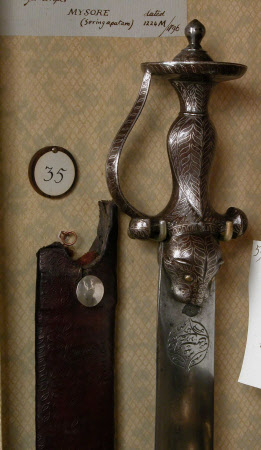Sword and scabbard
Category
Arms and armour
Date
1796
Materials
Brass, Silver, Steel
Measurements
955 mm (Length)
Place of origin
Mysuru (Mysore)
Order this imageCollection
Powis Castle and Garden, Powys
NT 1180608
Summary
A sword and scabbard, made in Srirangapatna, Mysuru (formerly known as Seringapatam, Mysore) in 1796. Both bearing a tiger-stripe motif and references to Haydar.
Full description
According to inscriptions on the sword and scabbard, these were manufactured at in Srirangapatna, Mysuru (formerly known as Seringapatam, Mysore). This was the site of the palace and court of Tipu Sultan (1750-99), who reigned from 1782-99. The sword is dated to 1224 of the Mauludi era, a calendar adopted by Tipu, which counted the years from 572 AD, understood by Tipu to be the year of the birth of the Prophet Muhammad. Tipu Sultan succeeded his father as ruler of the South Indian state of Mysuru in 1782, where he built a sophisticated court around his palace at Srirangapatna (formerly known as Seringapatam). Tipu was a powerful ruler whose reign was characterised by military conflict and reform. During his 17-year reign, Tipu introduced direct revenue collection, changes to land ownership, investment in agriculture and industrialisation, and social reforms. He also supported the establishment of factories and trading companies beyond Mysuru and the immigration of skilled foreign workers in order to develop local capability to produce modern firearms [Satyanarayana, p. 2245-7]. Tipu associated himself with a tiger motif, a powerful emblem in pre-colonial India. Many items associated with Tipu bear representations of tigers and tiger stripes, including arms, coins, book bindings, and eight tiger-head finials from his throne [Brittlebank, p. 258-9]. One finial was acquired by Edward and Henrietta Clive after the sack of Srirangapatna in 1799 [NT 1180713]. Research Note on Provenance Tipu Sultan spent much of his reign engaged in the defence of Mysuru against encroachment by the British East India Company. In 1798, a renewed British campaign provoked the Fourth Anglo-Mysore War. On 4th May 1799, during the Siege of Srirangapatna, Tipu was killed. In the immediate aftermath, the British army looted the town. According to Colonel Arthur Wellesley, later the Duke of Wellington, ‘Scarcely a house in the town was left unplundered, and I understand that in camp jewels of the greatest value, bars of gold etc etc have been offered for sale in the bazaars of the army by our soldiers, sepoys and followers. I came in to take command of the army on the morning of the 5th and with the greatest exertion, by hanging, flogging etc etc in the course of that day I restored order…’ [Dalrymple, p. 351]. The resumption of control by the higher ranks of the army enabled the work of the prize committee to begin. Prize committees were responsible for ‘collecting, inventorying and disposing of booty seized from the enemy and for … seeking to establish combatants’ entitlement to prize' [Finn, p.17]. They were intended to prevent the kind of undisciplined plunder which Wellesley reported in the aftermath of Tipu’s defeat at Srirangapatna. More than 1,000 commissioned officers took their allotted share in the captured property, which they kept, exchanged or sold to others. High value, or high-profile items, were excluded from the prize committee’s remit, and given to senior civil and military personnel, as well as the British royal family. Not all articles were genuine: tenuous or spurious attributions to Tipu Sultan have been identified in objects which were brought to Britain. Recent work on a sword at the Wallace Collection [OA1402] has shown that an inscription on the blade suggesting personal ownership by Tipu was added after his death in 1799.
Provenance
Part of the associated collection of Powis Castle which Edward Henry Herbert, 5th Earl of Powis agreed with the Commissioners of the Inland Revenue to be accepted in part satisfaction to the extent of £158,400 of the Estate duty for which he was accountable in connection with the death of the Right Honourable George Charles, 4th Earl of Powis, on 9th November 1952. Acceptance was effected when the objects were delivered in good condition to the Representative of the Treasury. The contract of the 'Offer of Property in Satisfaction of Estate Duty under the National Land Fund Scheme' was completed on 21st March 1963. This collection of chattels was accepted in lieu of tax by Her Majesty's Treasury and immediately transferred to the ownership of the National Trust on 29th November 1963 as the Treasury saw it desirable that the objects should remain associated with Powis Castle. Agreed by National Trust, Powis Estate Trustees and John George Herbert, 8th Earl of Powis in 25th June 2009 that this item is part of the collection of items transferred to the Treasury in 1963 and therefore owned by the National Trust.
References
2019 Dalrymple: W Dalrymple, The Anarchy: The Relentless Rise of the East India Company, Bloomsbury 2019 2018 Finn: Margot Finn, ‘Material Turns in British History I: Loot’, Transactions of the Royal Historical Society, Vol. 28, December 2018 2004 Satyanarayana: A Satyanarayana ‘Review: The Mysore Sultans. State and Diplomacy under Tipu Sultan: Documents and Essays by Irfan Habib’ Economic and Political Weekly 39 24 (2004) 1995 Brittlebank: K Brittlebank, ‘Sakti and Barakat: The Power of Tipu’s Tiger. An Examination of the Tiger Emblem of Tipu Sultan of Mysore’, Modern Asian Studies 29 2 (1995) Archer, Rowell and Skelton 1987 Mildred Archer, Christopher Rowell, and Robert Skelton, Treasures from India: The Clive Collection at Powis Castle, London, 1987

